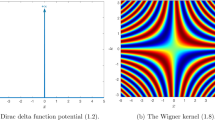Abstract
Unbounded potentials are always utilized to strictly confine quantum dynamics and generate bound or stationary states due to the existence of quantum tunneling. However, the existed accurate Wigner solvers are often designed for either localized potentials or those of the polynomial type. This paper attempts to solve the time-dependent Wigner equation in the presence of a general class of unbounded potentials by exploiting two equivalent forms of the pseudo-differential operator: integral form and series form (i.e., the Moyal expansion). The unbounded parts at infinities are approximated or modeled by polynomials and then a remaining localized potential dominates the central area. The fact that the Moyal expansion reduces to a finite series for polynomial potentials is fully utilized. In order to accurately resolve both the pseudo-differential operator and the linear differential operator, a spectral collocation scheme for the phase space and an explicit fourth-order Runge–Kutta time discretization are adopted. We are able to prove that the resulting full discrete spectral scheme conserves both mass and energy. Several typical quantum systems are simulated with a high accuracy and reliable estimation of macroscopically measurable quantities is thus obtained.













Similar content being viewed by others
References
Kierig, E., Schnorrberger, U., Schietinger, A., Tomkovic, J., Oberthaler, M.K.: Single-particle tunneling in strongly driven double-well potentials. Phys. Rev. Lett. 100, 190405 (2008)
Weiner, J.H., Tse, S.T.: Tunneling in asymmetric double-well potentials. J. Chem. Phys. 74, 2419–2426 (1981)
Ka, J., Shin, S.: Tunneling dynamics in a double-well: numerical studies with thermal wavepackets. J. Mol. Struct. 623, 23–30 (2003)
Pilar, F.L.: Elementary Quantum Chemistry, 2nd edn. Dover Publications, New York (2013)
Tucherman, M.E., Perez, A.P., Muser, M.H.: A comparative study of the centroid and ring-polymer molecular dynamics methods for approximating quantum time correlation functions from path integrals. J. Chem. Phys. 130, 184105 (2009)
Wigner, E.: On the quantum corrections for thermodynamic equilibrium. Phys. Rev. 40, 749–759 (1932)
Tatarskiĭ, V.I.: The Wigner representation of quantum mechanics. Sov. Phys. Usp. 26, 311–327 (1983)
Kluksdahl, N.C., Kriman, A.M., Ferry, D.K., Ringhofer, C.: Self-consistent study of the resonant-tunneling diode. Phys. Rev. B 39, 7720–7735 (1989)
Frensley, W.R.: Boundary conditions for open quantum systems driven far from equilibrium. Rev. Mod. Phys. 62, 745–791 (1990)
Biegel, B.A.: Quantum Electronic Device Simulation. Ph.D. thesis, Stanford University (1997)
Ringhofer, C.: A spectral method for the numerical simulation of quantum tunneling phenomena. SIAM J. Numer. Anal. 27, 32–50 (1990)
Shao, S., Lu, T., Cai, W.: Adaptive conservative cell average spectral element methods for transient Wigner equation in quantum transport. Commun. Comput. Phys. 9, 711–739 (2011)
Xiong, Y., Chen, Z., Shao, S.: An advective-spectral-mixed method for time-dependent many-body Wigner simulations. SIAM J. Sci. Comput. 38, B491–B520 (2016)
Markowich, P.A., Ringhofer, C.A., Schmeiser, C.: Semiconductor Equations. Springer, Wien (1990)
Schleich, W.P.: Quantum Optics in Phase Space. Wiley, Berlin (2011)
Thomann, A., BorzÌ, A.: Stability and accuracy of a pseudospectral scheme for the Wigner function equation. Numer. Methods Partial Differ. Equ. 33, 62–87 (2017)
Furtmaier, O., Succi, S., Mendoza, M.: Semi-spectral method for the Wigner equation. J. Comput. Phys. 305, 1015–1036 (2016)
Bund, G.W., Tijero, M.C.: Mapping Wigner distribution functions into semiclassical distribution functions. Phys. Rev. A 61, 052114 (2000)
Flügge, S.: Practical Quantum Mechanics. Springer, Berlin (1971)
Kaczor, U., Klimas, B., Szydlowski, D., Woloszyn, M., Spasak, B.J.: Phase-space description of the coherent state dynamics in a small one-dimensional system. Open Phys. 14, 354–359 (2016)
Gottlieb, S., Shu, C.W.: Total variation diminishing Runge–Kutta schemes. Math. Comput. 67, 73–85 (1998)
Sellier, J.M., Dimov, I.: Wigner functions, signed particles, and the harmonic oscillator. J. Comput. Electron. 14, 907–915 (2015)
Somorjai, R.L., Hornig, D.F.: Double-minimum potentials in hydrogen-bonded solids. J. Chem. Phys. 36, 1980–1987 (1962)
Pruess, S., Fulton, C.T.: Mathematical software for Sturm–Liouville problems. ACM Trans. Math. Softw. 19, 360–376 (1993)
Shao, S., Cai, W., Tang, H.: Accurate calculation of Green’s function of the Schrödinger equation in a block layered potential. J. Comput. Phys. 219, 733–748 (2006)
Grabert, H., Weiss, U.: Quantum tunneling rates for asymmetric double-well systems. Phys. Rev. Lett. 54, 1605–1608 (1985)
Zurek, W.H.: Decoherence and the transition from quantum to classical. Phys. Today 44, 36–44 (1991)
Budaca, R.: Harmonic oscillator potential with a sextic anharmonicity in the prolate \(\gamma \)-rigid collective geometrical model. Phys. Lett. B 739, 56–61 (2014)
Heilbronner, E., Rutishauser, H., Gerson, F.: Eigenwerte, Eigenfunktionen und thermodynamische Funktionen des linearen Oszillators \(6^{\text{ ter }}\) Potenz. Helv. Chim. Acta 42, 2304–2314 (1959)
Gerson, F.: Der eindimensionale Oszillator \(6^{\text{ ter }}\) Potenz als Basis für ein symmetrisches Doppelminimun-Problem. Helv. Chim. Acta 44, 471–476 (1961)
Davis, M.J., Heller, E.J.: Comparisons of classical and quantum dynamics for initially localized states. J. Chem. Phys. 80, 5036–5048 (1984)
Acknowledgements
This research is supported by grants from the National Natural Science Foundation of China (Nos. 11471025, 11421101, 11822102). Z. C. is partially supported by Peking University Weng Hongwu original research fund (No. WHW201501). Y. X. is partially supported by The Elite Program of Computational and Applied Mathematics for PhD Candidates in Peking University. The authors are grateful to the useful discussions with Wei Cai, Jian Liu and Jing Shi.
Author information
Authors and Affiliations
Corresponding author
Rights and permissions
About this article
Cite this article
Chen, Z., Xiong, Y. & Shao, S. Numerical Methods for the Wigner Equation with Unbounded Potential. J Sci Comput 79, 345–368 (2019). https://doi.org/10.1007/s10915-018-0853-0
Received:
Revised:
Accepted:
Published:
Issue Date:
DOI: https://doi.org/10.1007/s10915-018-0853-0
Keywords
- Wigner equation
- Moyal expansion
- Spectral method
- Quantum dynamics
- Unbounded potential
- Uncertainty principle
- Double-well
- Pöschl–Teller potential
- Anharmonic oscillator




